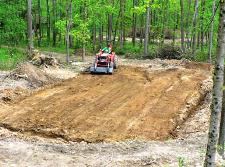Best Residential Pole Barn Foundation with Clay Soil and High Water Table
Reader BOB in MOUNT PLEASANT writes:
“What would be the best type of pole barn foundation for ground that is primarily clay, and has a water table that is generally as shallow as 24″? We are looking to build a residential pole barn style structure on the property. Thanks so much for your consideration.”
Mike the Pole Barn Guru writes:
Here are seven clay types as defined by USDA:
Silt: 80 percent or more silt and less than 12 percent clay.
Sandy clay loam: 20 to 35 percent clay, less than 28 percent silt, and 45 percent or more sand.
Clay loam: 27 to 40 percent clay and 20 to 45 percent sand.
Silty clay loam: 27 to 40 percent clay and less than 20 percent sand.
Sandy clay: 35 percent or more clay and 45 percent or more sand.
Silty clay: 40 percent or more clay and 40 percent or more silt.
Clay: 40 percent or more clay, less than 45 percent sand, and less than 40 percent silt.
Only way to be sure of your clay soil composition is to have it tested. However, you can also make a good clay content in your soil by referencing nearby geotechnical reports.
For a quick informal on-site test, try grabbing a handful of soil and rolling it in your hand. If soil can be rolled into thin spaghetti-like shapes, it indicates a high clay content. If soil begins to fall apart as you roll it between your hands, it means there is a lower clay content.
 My own particular site was once shallow lake bottom – probably closest to silty clay. In order to build upon it, we removed several feet of native soil, then built the site up using roughly five feet of compactable fill, in lifts of no greater than six inches. Exterior was graded to slope away from the building for 10 or more feet at a 5% or greater grade. As the site has a natural grade from left rear to front right, we should have also added french drains along left sidewall and rear endwall to divert underground water flow (although we have not experienced challenges with this over nearly 20 years of service). We used glu-laminated columns, embedded in ground, with concrete bottom collars and have had no column deterioration or movement problems.
My own particular site was once shallow lake bottom – probably closest to silty clay. In order to build upon it, we removed several feet of native soil, then built the site up using roughly five feet of compactable fill, in lifts of no greater than six inches. Exterior was graded to slope away from the building for 10 or more feet at a 5% or greater grade. As the site has a natural grade from left rear to front right, we should have also added french drains along left sidewall and rear endwall to divert underground water flow (although we have not experienced challenges with this over nearly 20 years of service). We used glu-laminated columns, embedded in ground, with concrete bottom collars and have had no column deterioration or movement problems.
Given your description of your site, a similar solution may prove adequate, however I would recommend you engage a professional Geotechnical Engineer to do a physical site evaluation and design a solution specific to your circumstances. Think of it as being a small investment towards success, rather than being an expense.






